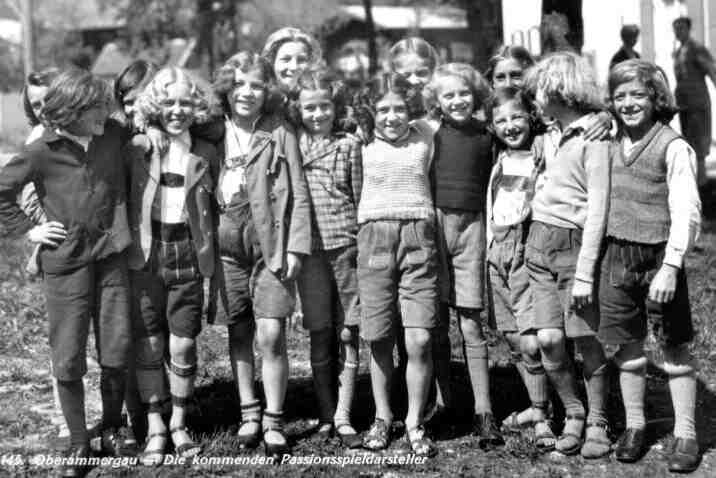
Oberammergau Passionsspledarsteller: Children Participating (1930)

Figure 1.--Here we notice a postcard with the caption "Die kommenden Passionsspieldarsteller" That means the next Passion Play actors. We at first thought the children were girls, but notice they are wearing Lederhosen. I am guessing that the children are boys who grew long hair for roles in the Passion Play. I am not sure, but I would guess that this is in preparation for the 1930 production.
|
Here we notice a postcard with the caption "Die kommenden Passionsspieldarsteller" That means the next Passion Play actors. We at first thought the children were girls, but notice they are wearing Lederhosen. I am guessing that the children are boys who grew long hair for roles in the Passion Play. I am not sure, but I would guess that this is in preparation for the 1930 production.
The Oberammergau Passion Play is the most well-know surviving passion play and dates to the 17th century. At that time the villagers who were terrified of an outbreak of bubonic and pledged that they would organize a production of a passion play every 10 years. After the plague seems to have subsided in 1633, the village held their first production of the Passion Play in 1634. This was a time that authorities had supressed most surviving medieval Passion plays. They changed to decennial years in 1700. There have been only a few years in which the play has not be performed, during the Franco-Prussian War (1879) and during World War II when the NAZIs banned religious plays. The village now produces it Passion Play during the first year of each decade. It continues to be an entirely local production and more than 2,000 village residents participate. As can be seen here the village children also participate (figure 1). For the folks scenes there are also kids, boys with long hairs and girls with pigtails. The Oberammergau Passion Play includes spoken drama, musical and choral accompaniment, as well as a Biblical tableaux vivants, including Old Testament scenes presented as background for the appearance of Christianity. (shifting to decennial years in 1700), except in 1870 during the Franco-Prussian War and during World War II, when religious plays were banned.
Chronology
I at first thought that the postcard here was taken in preparation of the 1950 production. There was because of World War II no 1940 prouction, so the postcard here must show children involved in either the 1930 or 1950 production. A reader writes, however, "I was a bit surprised by your dating of 1950. You may well be right, but note the length of the Lederhosen that the boys are wearing--almost knee length and in the case of the boy on the extreme left who is wearing long stockings, the knee pants are long enough to extend a bit below his knees. I would have thought that trousers this long belonged to an earlier--or maybe later--decade. Note also the boy on the extreme right. He wears tan long stockings that have been unattached from the garters on his Leibchen and rolled down to below knee length. This is interesting because we have several bits of evidence that boys often rolled down their long stockings below the knee when they were away from the oversight of their mothers who wanted them to wear the long stockings up and properly gartered. Professor Rudel mentions this practice. Most of the boys seem to wear the Bavarian-style knee socks with Lederhosen, but at least two of the boys are wearing long stockings. We also have corroborative evidence on HBC of the practice of wearing long stockings with Lederhosen." Our reader may well be correct. I at first thought this might be a 1950 photograph because of the open-toed sandals which were not very common in the 1930s. After thinking about it, the sandals may be part of Biblical costuming. And the strapshoes two children wear would be more likely seen in the 1930s. And as our reader mentions, the boy o the extreme left might dress that way in 1930, but probably not in 1950. A reader writes,"I think you are correct that part of the dating problem here is complicated by the fact that the children may be partly dressed in costumes and not wearing just street clothes. But they are not entirely in costume either, so the issue becomes a bit ambiguous. The long knee trousers don't look much like 1950, to be sure, but this also
could be part of the costuming."
Child Participants
A good part of the village prticipates in the Passion Play. I'm not sure what parts they play. A reader tells us that they are cast in folk scenrs. Tht would explain the Lederhosen here. I'm not sure whythe boys need long hair.
Gender
We at first thought the children were girls, but notice they are wearing Lederhosen. I am guessing that the children are boys who grew long hair for roles in the Passion Play. Most of the children look like boys with long hair. A few look like girls. I am not sure why the girls wear Lederhosen. Girl;s at the time wore dresses. Perhaps the girls here are playing boys. Or perhaps all the children are boys.
HBC

Navigate the Boys' Historical Clothing Web Site:
[Return to the Oberammergau Passion Play]
[Return to the Main German festival page]
[Introduction]
[Activities]
[Biographies]
[Chronology]
[Clothing styles]
[Countries]
[Girls]
[Bibliographies]
[Contributions]
[Essays]
[FAQs]
[Glossaries]
[Satellites]
[Tools]
[Boys' Clothing Home]
Created: 1:12 AM 6/20/2006
Last updated: 10:34 PM 6/22/2006



